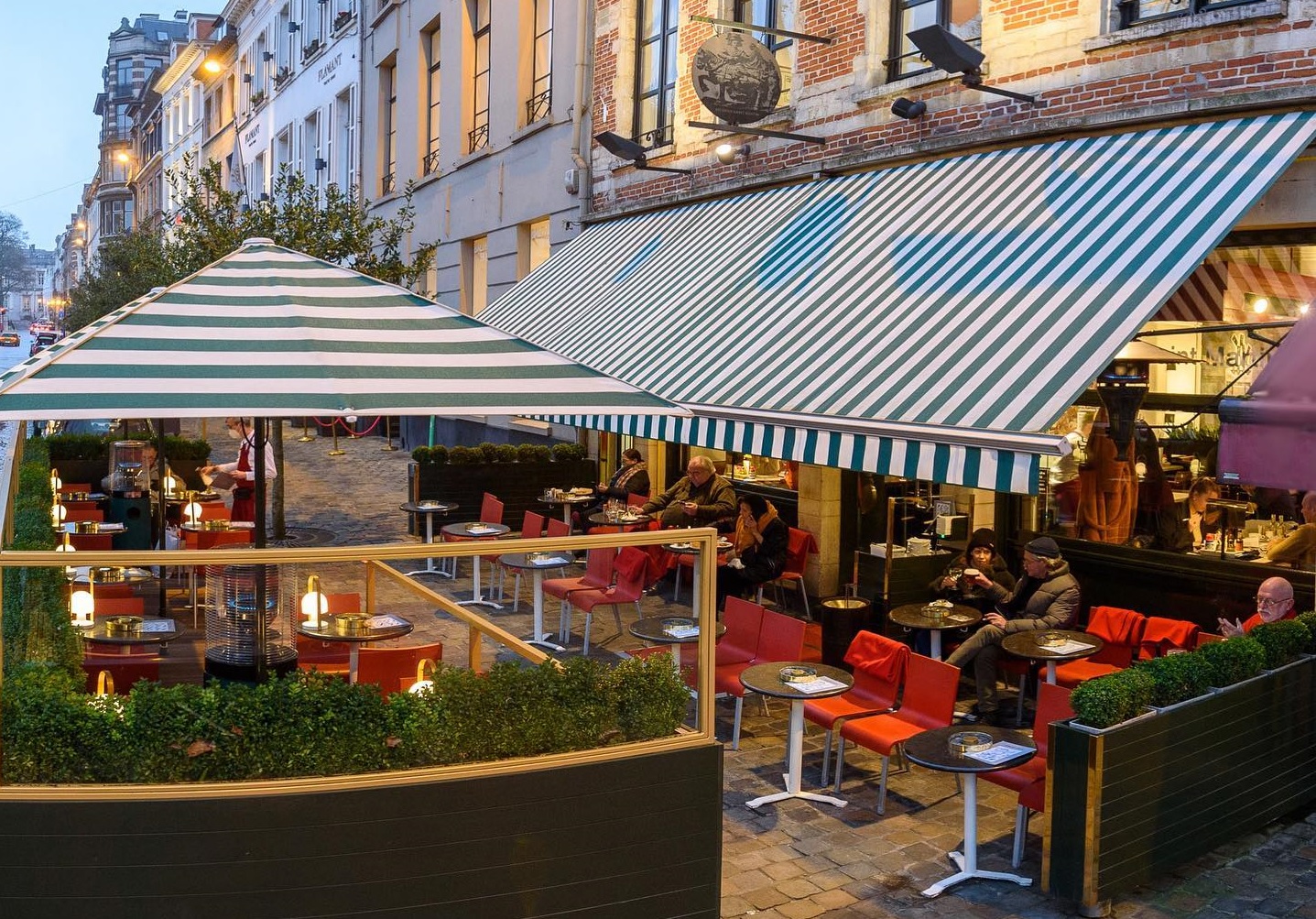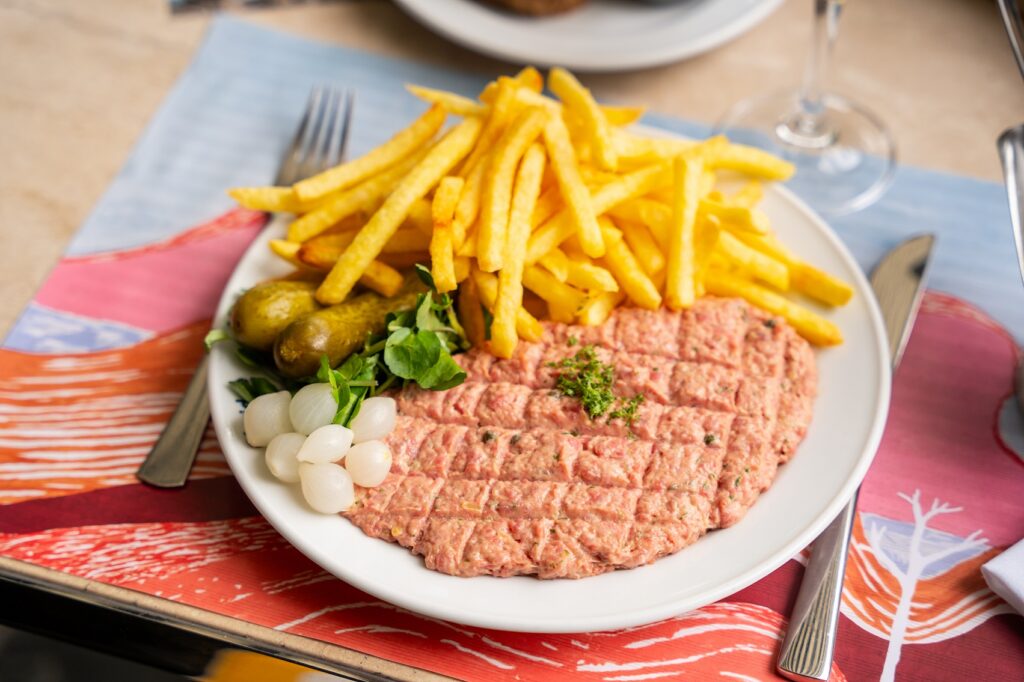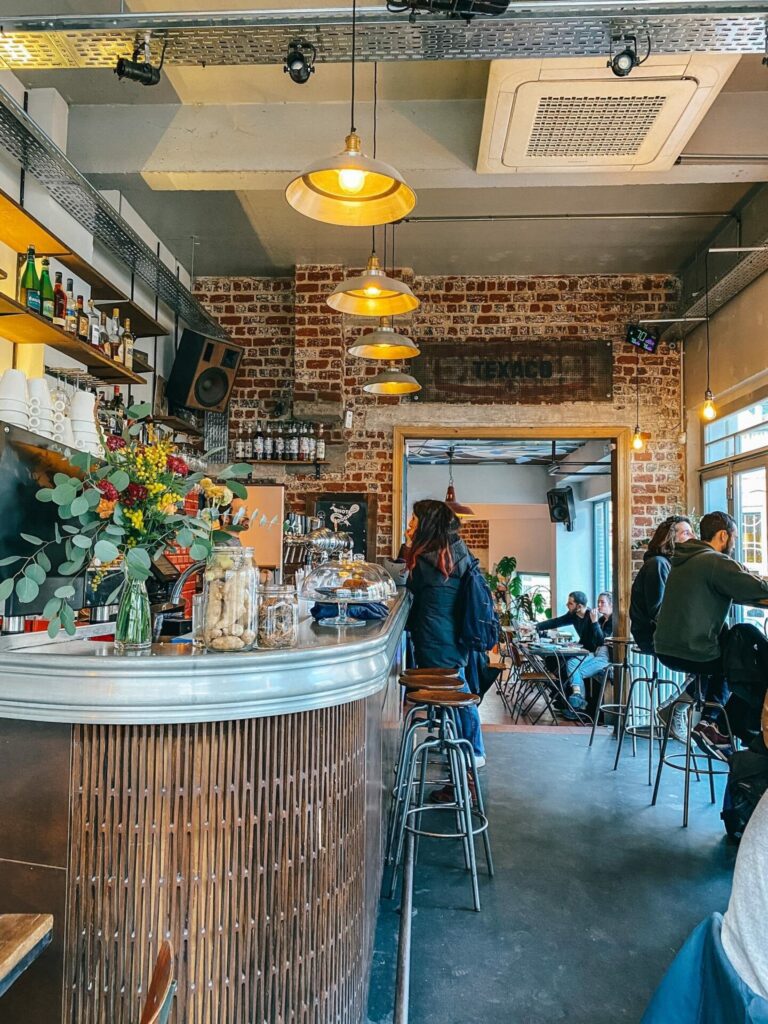Restaurant: Au Vieux Saint Martin
There are a few must-do food experiences in Brussels and eating a filet américain at Au Vieux Saint Martin is one of them. Not only because the dish was invented by the ancestor of the owners, but also because it’s part of Brussels folklore.
The terrace on the Sablon square offers a rare possibility to be seated Paris-style, i.e. facing the square rather than facing each other. However, the comparison with the French capital ends here, mostly because the service is much friendlier at Au Vieux Saint Martin. There’s always a maître d’ or his assistant making sure everything goes smoothly, and the waiters are top professionals. “We are an institution, we don’t want to be fashionable,” says Albert-Jean Niels, who runs the place with his son Frédéric, from their offices on the second floor. It says it all.
Au Vieux Saint Martin is like a bottle of top-brand champagne: you choose it because you know exactly what to expect in terms of service and quality, even with dishes that have changed very little since its opening in 1968. The furniture is original and the menu doesn’t change much besides adapting its suggestions list to seasonal supplies, and is a typical brasserie menu is that you can eat non-stop 7/7.
Their Ostend shrimps are the perfect to start your meal, be it in a tomato, on a toast or in a croquette. Besides the filet américain, other specials from the Belgian cuisine are also worth trying like the vol-au-vent, the pig’s trotters à la bruxelloise, the kidneys sauce Bister (mustard), the traditional carbonnades flamandes (beer-stewed beef) or the kip-kap (you don’t want to know what’s inside). But you can also go in all confidence for any fish or meat dish, perfectly cooked.
On the dessert list, the homemade ice cream is delicious in a dame blanche, i.e. covered with melted chocolate and whipped cream. But the flan maison (homemade pudding) is a revelation! It’s also one of the rare places in town where you can eat a genuine fresh Brussels waffle (crispier than the Liège one).
The wine list is mostly French – besides three classic Italians that have recently made their way in – and reflects the premium values of the house. A white sauvignon, yes, but from Bordeaux; a rosé, yes, but a cru classé (Château Roubine). And a fantastic house red from Ventoux, a Château Valcombe with its tailor-made label. The wine list includes a couple of second wines from renowned châteaux in Bordeaux and a few premium bottles at a good price for the connoisseurs.
Three beautiful hotel rooms on the third and fourth floor are available for rent if you want the full monty. All in all, a top Belgian food experience worth its price if you’re looking for excellence.
Au Vieux Saint Martin, Grand Sablon 38, 1000 Brussels
Food: Filet américain
The Belgian version of the steak tartare or minced raw beef as we know it today was born exactly 100 years ago. The recipe was invented by Joseph Niels, then director at the Taverne Royale in the Galerie Saint Hubert in Brussels. Before Niels, waiters used to prepare a steak tartare at the table where it was ordered, using their personal recipes, mixing minced meat, eggs, mustard, anchovies, garlic and often lemon juice. It meant neither the ingredients nor the quantities were standardised, and the final product varied a lot from one waiter to another, or even from one day to another.
Joseph Niels killed two birds with one stone: he standardised a recipe that was to be followed in the kitchen, while also allowing waiters to dedicate their complete attention to service.
Why ‘American’? Likely a reference to the steak tartare which was known in the early 20th century as steak à l’américaine.
“It’s the madeleine de Proust for most Belgians,” says Albert-Jean Niels, owner of Au Vieux Saint Martin (see article above). This year, the restaurant celebrates its flagship dish’s centennial, an impressive anniversary for this icon of Belgian cuisine invented by the owner’s ancestor. There, they use 30kg of meat every day to prepare the original filet américain, which is duly tasted before the first serving. Their ancestor’s recipe is dutifully followed at all their other restaurants as well (Au Grand Forestier in Boitsfort, Au Savoy in Uccle, Canterbury in Ixelles and Le Claridge in Waterloo).
Since 1924, the raw meat dish has become a classic and is on the menu of most Belgian restaurants. Some chefs even cut the meat with a sharp knife to obtain a different texture and enhance the taste of the beef. Martino, a chilli variation invented in Gent, includes Cayenne pepper, paprika and tabasco. A toast cannibale is a pair of slices of toasted bread spread with filet américain and served with pickled onions, cornichons, and a small salad. However, I would avoid filet américain, préparé or martino from supermarkets because they contain preservatives and other authorised chemicals and may include pork meat.
The original recipe
Exact proportions remain a family secret but, the ingredients are not: 175g minced beef (grosse-cuisse or tâche noire, i.e. rumsteak) per serving, mayonnaise sauce fortified with minced piccalilli, egg yolks, salt, pepper, sauce Worcestershire, minced onions and parsley, capers. No garlic, no lemon juice, no anchovy. Stir well with a wooden spoon to reach desired texture. Serve with French fries (not too thick), a bit of cress, minced onions, and Belgian/German pickles (sweet & sour, French ones being too acidic).
Drink: Midi Apéritifs
The perfect drink for this summer is Belgian! Its young Franco-Belgian founder, Jules Delaere, put the spirit of southern France in a bottle – think of Peter Mayle’s novels, and there you have it.
“Apéritifs are many things: they can be a spirit, a cocktail or the bite that goes with it,” Delaere explains. He points out that “Midi Apéritifs are less bitter than amari like Campari and have a fraction of the sweetness usually found in traditional vermouths.”
His wine-based apéritifs (those containing alcohol) are made with French wine, Mediterranean fruits, herbs, and roots, including Amalfi lemons, blackberries, rosemary, apricot, almonds, verbena, and bergamot. After maceration, the botanicals are vacuum distilled at a low temperature to pack them with flavour. The distillate is then used to fortify the wine and create a sweet beverage with a hint of bitterness which can be sipped on the rocks or in long drinks with tonic, Spritz or even sparkling wine.
You can choose between two alcoholic apéritifs (21%) and a non-alcoholic one. The Classic Red is based on shiraz rosé wine, fortified with distillates of blackberry and bergamot which make it fruity with a subtle hint of herbs from rosemary, fennel seeds and wormwood. The Liquid Sunset (read: the yellow one) is based on chenin wine, fortified with distillates of apricots, Amalfi lemons with a touch of bitterness brought by hints of lemon verbena, thyme, and almonds. “A vermouth on steroids,” according to its creator. So morish indeed. The non-alcoholic apéritif is dark red and is based on verjuice (juice from unripe grapes), which brings acidity, enhanced with blackberry, fig, and rosemary hydrolats. Very refreshing on the rocks with a tonic or simply sparkling water.
Delaere’s creations are sold online, but you can also buy them in Brussels at Le Comptoir Belge in Saint-Gilles. Low in alcohol, these made in Belgium (Kortrijk) drinks are complex in flavours and at the same time very accessible. Hopefully they put a little supplement of sun in your glass, which sometimes Belgium seem to lack in its sky.
Café: Café la Pompe
Brussels is a city full of surprises, some surreal. Texaco used to have a well-situated petrol station in the heart of Saint-Gilles, but like many others, it had to close ten years ago. Barmen Jalal and Johnny decided to retrofit the place and launch their own café.
Café la Pompe was born eight months later, nicely referring to both past and present activity. It’s a café with a soul, at a crossing of many streets, with some space between the huge terrace (100 seats) and the nearby houses. The alternative crowd of regulars from 8am to very late is mixed temporarily at noon with neighbourhood employees who can enjoy a quick but tasty lunch at €20 or so (including a €6 dessert).
Everything is homemade, even the pastries and the lemonade. Breakfast is a treat with scrambled or à la coque eggs, jam, ham, gravlax, you name it. The atmosphere in the morning bears the vibes of last evening – you feel like having a proper after-party! Service at the bar starts at 4pm, so until then you can even enjoy the luxury of a professional and friendly service, which is a rarity in Brussels. The evening snacks are incredibly cheap at less than €10 for a pulled pork burger or a garnished hot dog, or finger food at €5-7 or so.
But you come here to drink, of course. Teas come from Comptoir Florian, a reference. A couple of classic cocktails are at €10. The beer menu includes more local beers, but you can sip Brasserie de la Senne specials and a quite refreshing Gasoline, in partnership with local micro-brewery En Stoemelings. The wine list is reduced to a minimum, but they are carefully chosen – natural wines included.
What makes this place more special than any other in Brussels? It’s a local anchor, definitely – like in Barcelona, where cafes can be found anywhere in residential areas. Having said that, neighbours may have some issues with the noise of the busy terrace, especially on Thursdays and Fridays when DJs are invited. But the place itself is the main character, with its multi-level terrace and its separate rooms inside (40 seats or so).
It’s the perfect summer spot, with the pavement trapping the heat of the day late into the evening. Jalal and Johnny even kept the huge garage door, which creates a floor-to-ceiling opening of an entire wall when the weather is sunny. The many nomad workers who squat in the room from early morning hours are familiar with the bliss of working inside while feeling outside. A genuine Brussels experience at an incredibly affordable price.
Café la Pompe, Chaussée de Waterloo 211, 1060 Saint-Gilles




